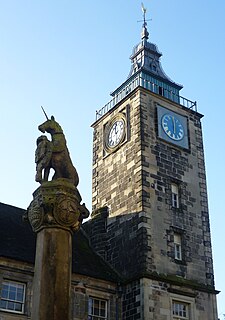
James Keir Hardie was a Scottish trade unionist and politician. He was a founder of the Labour Party, and served as its first parliamentary leader from 1906 to 1908.

James Wilson, commonly known as "Purly Wilson," was a Scottish revolutionary, born in the parish of Avondale in Scotland, a prominent figure in the Radical movement seeking electoral reform. He was a weaver from the town of Strathaven in Lanarkshire, but as the Industrial Revolution affected the weaving trade he had to find alternative work.

The Scottish Labour Party (SLP), also known as the Scottish Parliamentary Labour Party, was formed by Robert Bontine Cunninghame Graham, the first socialist MP in the Parliament of the United Kingdom, who later went on to become the first president of the Scottish National Party, and Keir Hardie, who later became the first leader of the Independent Labour Party and the Labour Party.
James Hardie Industries plc is a global building materials company and the largest global manufacturer of fibre cement products. Headquartered in Ireland, it is a dual-listed company, being listed on the Australian and New York Stock Exchanges. Its management team currently sits in Chicago, Illinois, United States. James Hardie was plagued by several asbestos-related scandals in the 20th century.

Joseph Hume FRS was a Scottish surgeon and Radical MP.

Bonnymuir was a moorland area near the town of Bonnybridge in Scotland. Today, it has mostly become either housing or farmland.
Andrew Hardie may refer to:

The Radical War, also known as the Scottish Insurrection of 1820, was a week of strikes and unrest in Scotland, a culmination of Radical demands for reform in the United Kingdom of Great Britain and Ireland which had become prominent in the early years of the French Revolution, but had then been repressed during the long Napoleonic Wars.
Sighthill is a neighbourhood in the Scottish city of Glasgow. It is situated north of the River Clyde and is part of the wider Springburn district in the north of the city. It is bordered to the north by Cowlairs, to the east by the Springburn Bypass road and the Royston neighbourhood, to the west by the Glasgow to Edinburgh via Falkirk Line and to the south by the Townhead interchange of the M8 Motorway.

John Baird was a Scottish revolutionary. A weaver by trade, he was brought up in the village of Condorrat. He is best remembered as a radical commander in the "Radical War" of 1820, and along with James Wilson and Andrew Hardie is the best remembered radical combatant in the "Radical War".

General Sir David Baird, 1st Baronet, of Newbyth, GCB was a British Army officer.
Events from the year 1820 in the United Kingdom. This year sees a change of monarch after a nine-year Regency.

Henry Brunner was an English chemist.

The Plinian Society was a club at the University of Edinburgh for students interested in natural history. It was founded in 1823. Several of its members went on to have prominent careers, most notably Charles Darwin who announced his first scientific discoveries at the society.

Sir John Hullock was an English lawyer and judge, a baron of the exchequer.
Events from the year 1820 in Scotland.
Ryan Hardie is a Scottish professional footballer who plays as a forward for Plymouth Argyle. Hardie started his career with Rangers, and was loaned by them to Raith Rovers, St Mirren and Livingston. In July 2019 he moved to English club Blackpool, with whom he remained for 18 months, before signing for Plymouth Argyle in January 2021.

Charles Martin Hardie was a Scottish artist and portrait painter.

Stirling Tolbooth is a municipal building in Broad Street, Stirling, Scotland. The structure, which was the original meeting place of Stirling Burgh Council, is a Category A listed building.














